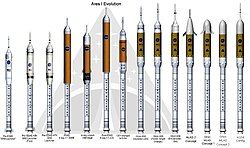Aiaa2
The first stage is a five-segment solid rocket booster providing 14,700 kN of thrust and derived from the Space Shuttle’s own SRBs (Solid Rocket Boosters). ATK will produce these and the identical boosters used on Ares V. The exhausted first stage will be recovered in the water, just like its predecessor, for testing and performance verification. The second stage is a fully-expendable cryogenic liquid booster to be built by Boeing and powered by a single J-2X engine derived from the second stage of the Saturn V moon rocket. This configuration is projected to deliver 25,000 kg to Low Earth Orbit.
The Orion CEV will sit on top of the second stage and be protected by a Launch Escape System during the initial stages of flight. The Launch Escape System consists of an aerodynamic protective cover that attaches over the Orion crew capsule and a tower equipped with solid-fueled escape motors and flight control hardware. To avoid a repeat of the Challenger incident, the crew is placed as far away from the actual rocket segments as possible. The Orion can be pulled away from the stack by the Launch Escape System's rocket motors in an emergency. The protective cover prevents damage to the crew capsule from debris and the exhaust of the escape motors.Relevante Bilder
Relevante Artikel
Ares IDie Ares I war eine geplante US-amerikanische Trägerrakete. Sie wurde speziell für Starts des Raumschiffs Orion entwickelt und sollte mit diesem zusammen das Space Shuttle als bemannte Rakete ablösen. In ihrer letzten geplanten Konfiguration war es der Ares I möglich, bis zu 24,5 Tonnen in einen niedrigen Erdorbit zu befördern. Zusammen mit ihrer Schwesterrakete Ares V war sie Teil des Constellation-Programms der NASA, das jedoch aufgrund finanzieller Engpässe vorzeitig eingestellt wurde. .. weiterlesen





